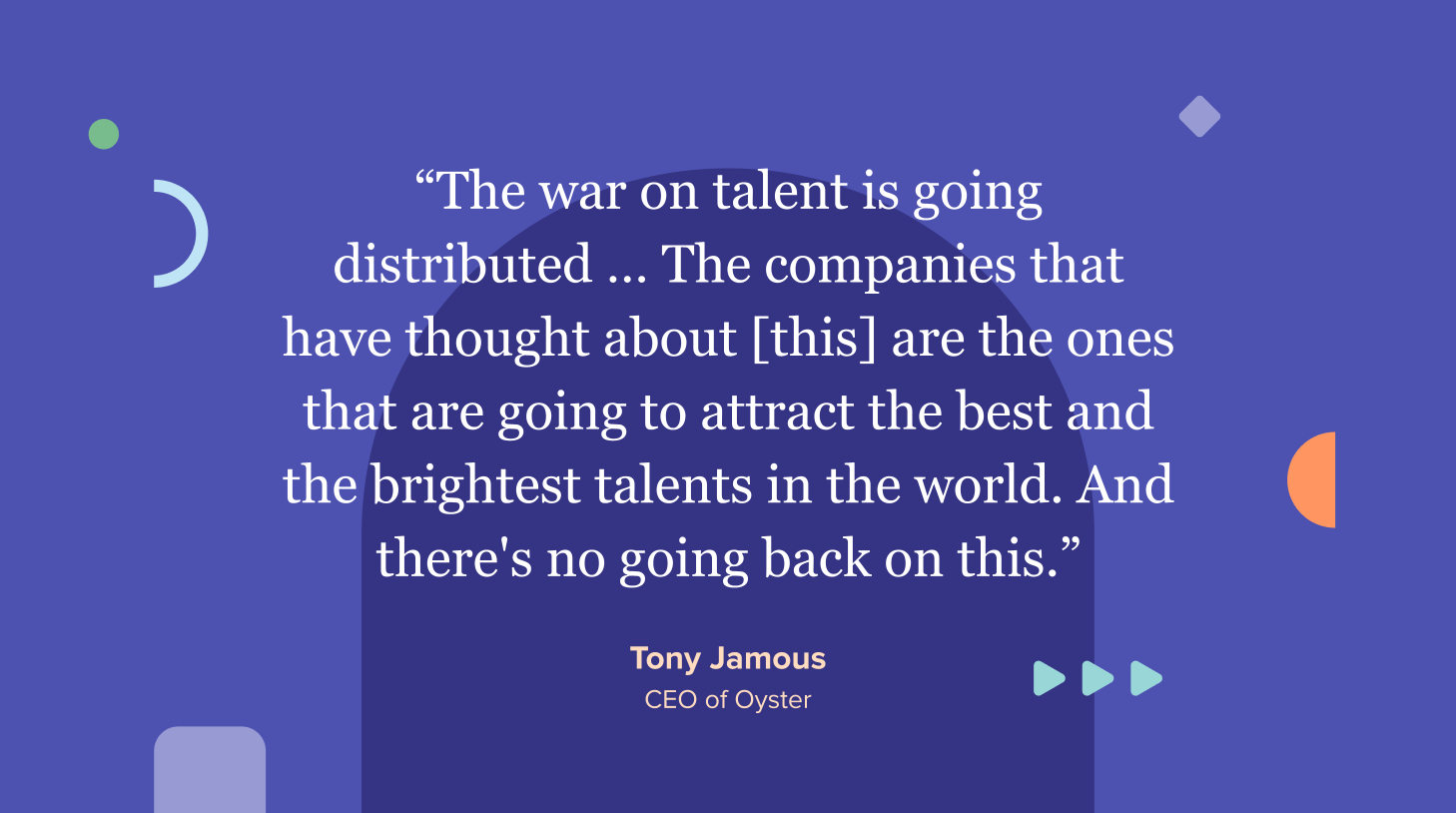The global talent market: the new land of opportunity is anywhere
Remote work is here to stay. And this means a global talent market for recruiters and HR professionals. For many jobs, your available pool of candidates is no longer restricted by location. You can now hire across locations, time zones, and even countries.

To better understand this new world of talent and how to benefit from it, we sat down with Tony Jamous, the CEO of Oyster, in our Better Hiring podcast, Oyster is a company self-billed as “a global HR platform for remote working, anywhere in the world.”
Jump straight into the podcast or check out the transcription here.
As a practiced expert in global talent management, Tony had a lot to say. Here are the top takeaways from our conversation:
Make the commitment, then make it work
Virgin mogul Richard Branson once said: ”If somebody offers you an amazing opportunity but you are not sure you can do it, say yes – then learn how to do it later!”
Tony would agree when it applies to the global talent market.
“My first tip here is to really focus on what’s really important, which is finding the best talent no matter where they are,” he says. “And worry later about these obstacles or these barriers that prevent you from hiring that talent.
Why? Because it makes sense
And forget whether your services are global or local. It makes a lot of sense to hire globally, because your talent market is much broader.
“If you were to say a startup in San Francisco or a startup in London, and you want to hire locally, what are the chances [that] the best talent will be in a 20-mile radius from your office? It’s like 0.1%,” Tony says.
“So how can you explain statistically that this is a good strategy for talent acquisition, where over 99% of the great talent is elsewhere?”
He points to hubs of engineering in areas such as Eastern Europe and Latin America that have a much higher representation of highly talented developers who specialize in specific coding languages – all of which presents an opportunity for smart companies who tap into the global hiring market.
Benefits of a global talent market
Talent distribution aside, Tony points to other benefits:
1) Local connectivity makes better EX
There are huge benefits in the new reality of living where we work and working where we live – especially for the employee.
Tony shares his own example.
“Now my identity is work but it’s also family. I spend more time with my children, with my partner,” he says of his work-life integration. “It’s my community as well.”
He talks about an elderly neighbor in the small French village where he lives and works. “He can’t walk very well. And his chimney broke in the middle of the winter and he needed somebody to take him to the store, buy something to come and fix the chimney. So he called me at 2 in the afternoon, and I had a 45-minute gap in my schedule.
“So I was able to go and bring him to the store and build it. And I felt more connected to him.”
And what does that mean for the new working environment?
“If I was in the office,” Tony explains, ”I would have missed that opportunity to help him out. And so I feel much more connected to my local community. So that’s good news for the world. And that’s good news for people.”
And when employees feel more connected to their families and communities even when on the job, they’ll be happier. That speaks volumes for overall employee engagement (EX) and experience.
2) Remote can outperform office
Tony says that, if executed properly, a remote-work environment can actually be more productive and engaged than the alternative.
“For instance, a virtual environment requires you to share leadership more, so essentially because everybody is in different locations and the leader cannot do everything like they used to do in the office, then suddenly you have an opportunity for other leaders to come in and fill that gap. So it becomes a great place to grow leaders faster in the business.”
It’s not just about collective leadership. Remote also fosters a more equitable and democratic working environment that brings the best out of people.
“The best ideas win,” Tony says. ”[W]hen you used to work in an office and you go to a meeting room and usually the loudest person in the room monopolizes the discussion, but you have maybe this introverted, brilliant person on the side [and] they’re not sharing their ideas.”
And now, working online across locations, there’s a more collaborative spirit via a shared document where everyone is able to bring something to the proverbial table, and have a conversation, Tony says.
“The role of the leader is really to be aware of these superpowers and create an environment that actually facilitates and fosters these benefits.”
3) There are social and environmental benefits
There’s an added intangible that can speak volumes for your employer brand: the social impact that your organization has as a remote-first organization.
“If you remove the barriers to cross-border employment and enable companies to really tap into the global talent pool, you can reduce brain drain, which is really one of the major impacts of wealth distribution issues in the world.”
There’s also an environmental impact as well.
“Think about it; every year, we’re pouring the equivalent of four New York Cities in terms of concrete on planet Earth. And in many cities, it’s not a more livable condition.”
He notes the example of Delhi, where workers lose an average of seven hours of life expectancy due to the air pollution.
“I think the pandemic enabled us to realize that actually we are past that tipping point of sustainability of cities. And, I hope that the world will reverse that trend now that actually it’s not a necessity to be in the office to get the job done, at least for knowledge workers.”
Global talent market best practices
Convinced? Tony now has some best practices for you when executing on a global talent market strategy.
1) Ensure equal opportunity and experience
When you have a distributed team, you need to align your company success with your employee success, Tony says. This ties into employee experience, which can differ across locations.
Tony shares the example of a contact center in India that worked night shifts to accommodate the US market.
“There’s something we don’t really talk about … this lifestyle disparity when it comes to working from anywhere. [A]s a leader of an organization, my recommendation is to create an environment and a culture that gives everybody an equal opportunity, no matter where they are.”
Balance out the opportunities
Also, when hiring for more senior positions in tech, you’ll also find that talent is more concentrated to specific locations. For example, Tony says, senior talent has been focused in the Western world in the last 30 years.
And that can lead to further imbalances when it comes to opportunity within a company.
“[It’s important] that you think about how you develop the younger talent that come from emerging economies and giving them the opportunity to grow with your company and with the opportunity,” Tony says, “so we can start building the next generation of tech leaders from all over the world and not necessarily focused or centered around certain technology hubs in the world, such as the Silicon Valley, or London, or China.”
This also applies to the overall nature of remote work, where it comes naturally to some and more of a challenge to others – again a recipe for imbalance and unequal experiences across teams.
“There are certain trainings [where] you can upskill your talent force on remote work. You can teach your team how to behave, how to be productive, how to take care of themselves so that they don’t burn out.”
Focus on the results
To ensure equal opportunity and growth across locations, Tony also recommends shifting to a results-driven model.
“We’ve seen companies that have this obsession with output rather than input. Essentially we don’t care how [many] hours you put in to get the job done, as long as you have clear goals and you’re delivering on your goals,” he says.
“That goes a long way to create a culture where there’s a high degree of trust in order for anybody, anywhere they are, to grow in and develop in your company.”
2) Establish a strong company culture
The reality of working across locations – and especially, across cultures – is that there will be some inconsistencies as colleagues of different backgrounds collaborate on projects. There are ways around that, however – and the first big takeaway from Tony is that a strong company culture is essential if you want to overcome these challenges.
In short – the collective vision can be very powerful. But, Tony says, it doesn’t happen on its own.
“My experience having led two companies in the last 10, 12 years is that [there] are people from all over the world. Company culture definitely trumps country culture. … But you have to manage it. It’s not like by default this is going to happen.
“So you need to really be clear about how you create a strong company culture that actually is stronger than in local cultural specificities.”
Learn how Belgium-based startup ProxyClick built a great company culture that unifies and inspires its employees.
3) Standardize and prescribe a virtual working system
Working in a remote working environment means you need to actively build trust among colleagues. In a physical workplace, Tony says, trust grows naturally, but in a virtual environment, you have to work at it.
He shares the example of working with his product team. Syncing in real time is needed to align on ideas around product development, but an equally strong element of building a strong virtual work culture is in carrying out the actual work as a team.
“[At Oyster], we call them ‘tools and the rules’,” says Tony, adding that while you can get away with lack of clarity if you’re working together in the same office, that’s not the case when working across time zones, cultures and backgrounds.
“You have to be very prescriptive of how you work together. What tools do you use? When do you use them? What different meetings do you have?” Tony says.
And this system can’t be dictated top-down. It needs to be mutually built across the team.
“And you, as a team manager, have to be the best remote worker in your team to show the example for your team that this is something that everybody needs to buy into, and it gets reinforced.”
4) Know how job attractors differ across cultures
Building a strong employer brand is essential to candidate attraction, of course. But that becomes a unique challenge when sourcing and attracting talent in different locations.
Tony agrees, sharing a hypothetical example of a person named Mary in Nigeria, who has the option to work at a local bank for a contract and the best benefits in the area.
“You want to be able to match that, you want to be able to understand what ‘good’ looks like in country X, and then extend a generous offer to that employee,” Tony says.
He adds the value of job security for someone like Mary.
“That goes to first hiring them as a full-time employee rather than a contractor, so that you can reduce their anxiety and provide them with the ability of having a stable job and a stable income. And then supplement that with whatever local benefits Mary expects to see from a top employer in that country.”
Benefits will be different as well
Tony then talks about other countries that put more weight on certain benefits, such as the United States where health insurance is an absolute must-have. In France, on the other hand, the expectation is more about restaurant vouchers, with health insurance more complementary rather than a core benefit.
In other countries still, health benefits are a non-issue because of a universal health care system.
There are also other elements at play in a global talent market, Tony says.
“[Maybe] there is a fear of cultural differences. Maybe people in that country think differently than people in that country. There are administrative and legal and tax challenges that companies have to go through. […] So every country is different and you have to navigate that.”
Adapt and thrive in the global talent market
“The war on talent is going distributed,” Tony says. “The companies that have thought about how to enable a strong culture, how to enable a distributed workforce to grow and develop – they are the ones that are going to attract the best and the brightest talents in the world. And there’s no going back on this.”
Employees have that expectation as well, and Tony says employers need to pay close attention to that.
“Employees are asking for an extra degree of freedom, which is location. [They] want to be able to live wherever they want to live,” he says.
“That’s hard for companies to manage if they want to go back to an office-only culture, because talent will go to wherever they have more freedom and that’s assuming equal pay and equal benefits.”
Tony adds that 1.5 billion knowledge workers will be entering the workforce in the next 10 years. He says this is the biggest labor democratic shift since the Industrial Revolution.
“We have that opportunity now as a world to rethink what work is and make it more sustainable and more focused on bringing that opportunity to people no matter where they are.”
Ultimately, the global talent market is about people and quality of life.
“We want to have a future where people have a choice in where they want to live. And they don’t necessarily have to live in the city. It becomes a choice if they decide to want to live in a city, but if they decide not to, they shouldn’t be forced to be living in a crowded space. And that’s the world that we want to portray [at Oyster].”





